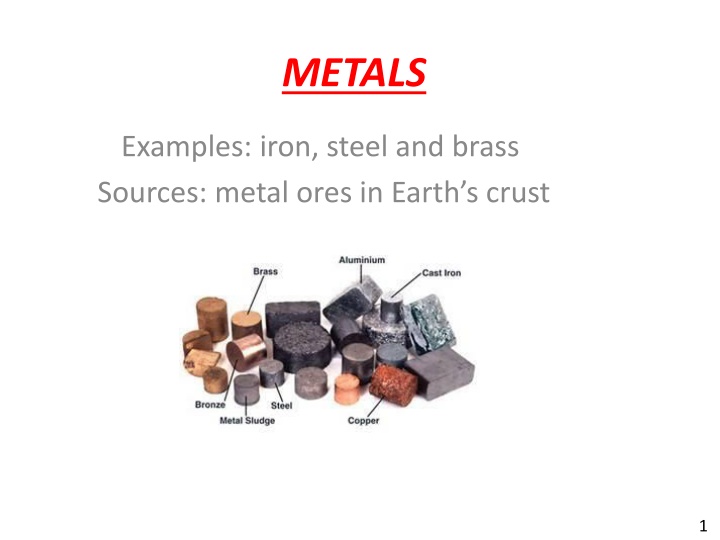
Materials and Elements in Science
This content provides insights into various materials and elements, including metals, plastics, ceramics, glass, and fibers. It discusses their properties, sources, and uses, emphasizing the importance of selecting the right material for different situations. The content also explores a range of elements, from alkali metals to noble gases, highlighting their significance in science and industry.
Download Presentation

Please find below an Image/Link to download the presentation.
The content on the website is provided AS IS for your information and personal use only. It may not be sold, licensed, or shared on other websites without obtaining consent from the author. If you encounter any issues during the download, it is possible that the publisher has removed the file from their server.
You are allowed to download the files provided on this website for personal or commercial use, subject to the condition that they are used lawfully. All files are the property of their respective owners.
The content on the website is provided AS IS for your information and personal use only. It may not be sold, licensed, or shared on other websites without obtaining consent from the author.
E N D
Presentation Transcript
METALS Examples: iron, steel and brass Sources: metal ores in Earth s crust 1
Plastics Examples: nylon and polystyrene Source: crude oil 2
Ceramics Examples: china,bricks and pots Sources: clay, sand and other materials 3
Glass Examples of glass: pyrex, lead and crystal The sources of glass are: limestoneand other materials 4
FIBERS Examples of materials: cotton, wool and polyestere The sources of fibers are: plants and animals 5
FEATURES: THE MATERIALS 1 )Number of materials 2) Factors of elements: Properties,the mass,any climatic,chemical and machining requirement 3) There is a better material for each situation. 4) MATERIALS ARE FROM THE ELEMENTS! 6
4 EXAMPLE OF ALL ELEMENTS ALKALI ALKALI METALS METALS ALKALINE ALKALINE HEART METALS HEART METALS TRANSITIONAL TRANSITIONAL METALS METALS OTHER OTHER MATERIALS MATERIALS Aluminium Tungsten Strontium Hydrogen Sodium Radium Lead Cobalt calcium, barium and other lithium, potassium and other chromium, manganese and other Bismuth, polinium and other NOBLE GASES NON-METALS Sulfur Arsenic Elium Xenon oxygen, nitrogen and other Radon, krypton and other 7
The ATOM The ATOM http://tse1.mm.bing.net/th?id=OIP.Mce7c464f6be39bcc8d74d1940905ff11H0w=268h=300c=0pid=1.9rs=0p=0 Nucleus Electrons Neutrons Protons 8
Metals and Non-Metals METALS NON-METALS Shiny, ductile, malleable Non metals are dull. They are neither ductile, nor malleable APPEARANCE Usually higher than non- metals Usually lower than metals, many are gases MELTING AND BOILING POINTS Good conductor of heat Poor conductors of heat HEAT CONDUCTIVITY SPECIFIC WEIGHT Heavier than non-metals Lighter than metals Good conductors Poor conductors CONDUCTORS OF ELECTRICITY 9
ALUMINIUM 10
ITS USED IN RESISTANT MATERIAL LEAD IN BATTERIES,GLASS CERAMICS AND VARIOUS ALLOYS SUCH AS PEWTER AND SOLDER LEAD IS RESISTANT TO OXIDATION,IT HAS BEEN WIDELY USED IN THE PAST FOR ROOFING AND WATER PIPES;IT HAS A LOW MELTING POINT COMMON METAL CHARACTERISTICS IT IS A SHIELD AGAINST RADIATION AND IS A POOR CONDUCTOR OF ELECTRICITY AND RESISTS CORROSION BY ACIDS THE LEAD IS RESISTANT TO OXIDATION,IT HAS BEEN WIDELY USED IN THE PAST FOR ROOFING AND WATER PIPES;IT HAS A LOW MELTING POINT
>COPPER< - ORANGE-PINK - VERY MALLEABLE - DUCTILE - COPPER AGE
BRASS Brass is an alloy Brass consists of copper mixed with zinc
Rubbers -Applications -Elastic properties -Designers
SAW Saw is used to cut wood or metals the handle is made up of wood/plastic while the upper part of steel
HAMMER It Is used to hammer nails The handle is made of wood/plastic while the upper part is made of iron and steel
DRILL It is used to make holes The drill is made up of plastic and the drill bit of steel
SPANNER It is used to loosen nuts It is made up of steel
PLIERS It is used to bend wires The handle is made up of plastic or rubber while the upper part is made of steel
SCREWDRIVER It is used to screw and unscrew The handle is made up of plastic or rubber while the upper part is made of steel
Grazie I nostri ringraziamenti vanno: Al D.S. Prof. Marzagalli Alla Prof.ssa Parini, Alla Prof.ssa Crepaldi Al Prof. Cacciato Alla 2 ATER.


